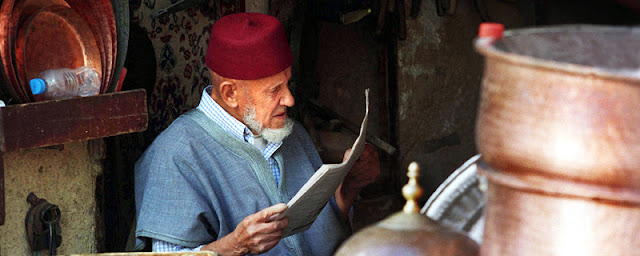The Souk Aamor Agdoud N’Oulmghenni, or the renowned Imilchil Moussem; the “Fête des Fiancés” or “Marriage Market”, is the most impressive of all the Berber mountain souks. Held at the end of summer, over three days late in September, it represents the annual meeting of the great family tribes Aït Haddidou, Aït Morghad, Aït Izdeg and Aït Yahia. A gathering of the Berber people of remote villages of the Middle and High Atlas mountain valleys and nomadic herders of the southern slopes leading to the fringes of the Sahara desert. John Horniblow reports for The View from Fez
Crossing from Middle Atlas into the High Atlas and up to Imilchil the Atlas Mountains presents formidable natural barrier that has maintained the autonomy of the Berber tribes of the mountains and the desert directly at their southern slopes for millennia. Wild sweeping vistas of stark mountain peaks and deep ravines are traversed by thin ribbons of bitumen that wind in narrow neck turns over the passes to reach the high plateau. In this week in September you jostle for space on the thin roads with steady stream of ancient red Bedford trucks (Berber taxis) either laden with goods, livestock and people heading to the moussem or brimming with wooden crates carrying the apple harvest out of the mountain valleys.
While named after Imilchil the moussem actually takes place in a small valley between Bouzmouz and Agoudal on the high plateau. From what might appear at first to be an informal souk and camp around the tomb of Sidi Ahmed Oulmghenni, a small temporary town of tents and stalls swells across two small hillsides with alleys of eateries, clothes markets, shoes stalls, grain markets, carpet traders and village weavers, Berber jewelers and desert traders. On one hillside of a lively trade of animals occurs on the first day. From the other side overlooked by nomadic families camped under the rock ledges high on the hill, the souk bustles with people keen to trade handicrafts, tools, buy and sell provisions, or simply amble watching and catching up with distant friends and family members. Then at night they celebrate with lively music, singing and dancing before the onset of winter snowfalls cuts them off from the rest of the world.
There are two main competing versions of stories that lay claim for the inception of the festival. They are both pragmatic and probably the real truth lies somewhere in between the romantic fact and fiction the two of them. As far as Berber legend goes two young people from different feuding tribes fell in love but, in a Moroccan triste akin to Romeo and Juliet, they were forbidden to see each other by their families. The grief of unrequited love led them to their deaths. One ending of legend tells that they cried themselves to death, creating the neighbouring deep alpine lakes of Isli (his) and Tislit (hers), near Imilchil. The second ending, equally dramatic, is that the lovers drowned themselves in the separate lakes. Accordingly the Imilchil Marriage Festival was founded as an anniversary to those lover’s death, and in a tribal tradition, as an opportunity for unmarried Berbers, particularly women trapped at altitude for most of the year, to survey and mingle with prospective spouses. For some it’s the opportunity to commit to the vow of marriage and commence the tying of the marital knot with their chosen love.
The second and more unromantic version of the story is that the marriage tradition purportedly derives from the French colonial times of the last century, when the foreign officials used to insist that the Berbers assembling for their yearly souk, registered their births, deaths and marriages. Most probably it is that act that instituted the official contract signing and noting of the exchange of vows we know them today. While its not apparent it is said that most marriage matches are arranged in advance and merely formalized at the moussem with the contract signing.
Need less to say, whatever version of the story you want to believe, the souk and moussem is a delightfully unique and colourful event. Small groups of young Berber women dressed in traditional finery and roughly, woven woollen robes distinctive to each family tribe, some with berber fibules (amulets), eyes rimmed with heavy black kohl, and intricately hennaed hands, amble through the commerce of the souk talking, flirting with or being approached by the potential bachelors trying to strike up meaningful conversation. The wary eyes of elder relatives, looking on, following them protectively at a furtive distance.
On the second day of this year’s moussem, under the white and black appliqué of the official Moroccan tent, 29 young couples apprehensively waited to make their vows at the public ceremony. A large crowd of onlookers sparsely sprinkled with few tourist eyes, Moroccan media and a few film documentary crews looked on from a short distance. For all the sense of frivolity surrounding the evident flirting, courtship and mingling in the souk the young nuptial couples sat in nervous congregation before approaching the officials together and solemnly signing their betrothal contract with the stamp of their inked thumbs. Then each couple, striding from the official’s tents, amidst the celebratory rhythmic tamborines, singing and shrill tongue warbles, successively broke through the parted circle of the crowd. Stepping over the threshold of tradition and through the open door of their married lives ahead of them.
Text and photographs: John Horniblow
SHARE THIS!

















2 comments:
excellent article and photos
That's really nice post about Imilchil Marriage Festival.
Post a Comment